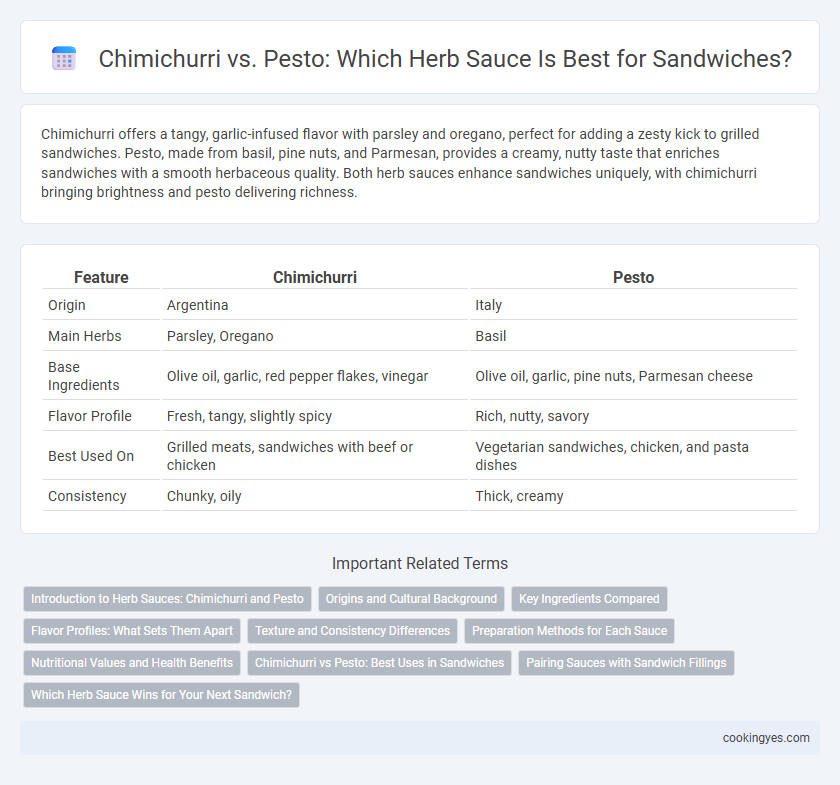Chimichurri offers a tangy, garlic-infused flavor with parsley and oregano, perfect for adding a zesty kick to grilled sandwiches. Pesto, made from basil, pine nuts, and Parmesan, provides a creamy, nutty taste that enriches sandwiches with a smooth herbaceous quality. Both herb sauces enhance sandwiches uniquely, with chimichurri bringing brightness and pesto delivering richness.
Table of Comparison
| Feature | Chimichurri | Pesto |
|---|---|---|
| Origin | Argentina | Italy |
| Main Herbs | Parsley, Oregano | Basil |
| Base Ingredients | Olive oil, garlic, red pepper flakes, vinegar | Olive oil, garlic, pine nuts, Parmesan cheese |
| Flavor Profile | Fresh, tangy, slightly spicy | Rich, nutty, savory |
| Best Used On | Grilled meats, sandwiches with beef or chicken | Vegetarian sandwiches, chicken, and pasta dishes |
| Consistency | Chunky, oily | Thick, creamy |
Introduction to Herb Sauces: Chimichurri and Pesto
Chimichurri and pesto are vibrant herb sauces that elevate sandwich flavors with their unique profiles. Chimichurri, rooted in Argentine cuisine, combines fresh parsley, garlic, olive oil, vinegar, and chili flakes for a tangy and slightly spicy punch. Pesto, originating from Italy's Liguria region, blends basil, pine nuts, garlic, Parmesan cheese, and olive oil to create a rich, aromatic sauce with a creamy texture.
Origins and Cultural Background
Chimichurri, originating from Argentina and Uruguay, is a vibrant herb sauce traditionally made with parsley, garlic, oregano, vinegar, and olive oil, reflecting the region's Gaucho culture and preference for robust, tangy flavors. Pesto hails from Liguria, Italy, specifically Genoa, featuring basil, pine nuts, garlic, Parmesan cheese, and olive oil, embodying Mediterranean culinary traditions with its fresh, aromatic, and creamy profile. Both sauces enhance sandwiches uniquely, with chimichurri offering a zesty, rustic punch and pesto providing a rich, herbaceous complement rooted in Italian coastal heritage.
Key Ingredients Compared
Chimichurri features fresh parsley, garlic, red wine vinegar, oregano, and olive oil, creating a tangy and herbaceous profile ideal for grilled meats. Pesto combines basil, pine nuts, garlic, Parmesan cheese, and olive oil, offering a rich, creamy texture with a nutty and savory flavor. Both sauces highlight fresh herbs and garlic but differ significantly in acidity, creaminess, and key flavor components, making them suitable for diverse sandwich styles.
Flavor Profiles: What Sets Them Apart
Chimichurri offers a bold, tangy flavor with fresh parsley, garlic, vinegar, and red pepper flakes creating a zesty, slightly spicy profile ideal for grilled meats in sandwiches. Pesto features a rich, creamy blend of basil, pine nuts, Parmesan cheese, and olive oil, delivering a sweet, nutty, and aromatic taste that complements Italian-style sandwiches. The distinct herb bases and seasoning differences set chimichurri's sharp vibrancy apart from pesto's smooth nuttiness, defining their unique roles in sandwich flavor enhancement.
Texture and Consistency Differences
Chimichurri offers a coarse, chunky texture with visible herb bits and a loose, oily consistency that enhances sandwiches with a fresh, zesty bite. Pesto, by contrast, is smoother and thicker, blending basil, pine nuts, and cheese into a creamy sauce that adheres well to bread and fillings. The oil-to-solid ratio in chimichurri creates a lighter spread, while pesto's denser composition provides a richer, more uniform coating.
Preparation Methods for Each Sauce
Chimichurri is prepared by finely chopping fresh parsley, garlic, oregano, and red chili flakes, then mixing them with olive oil, red wine vinegar, and salt to create a vibrant, slightly chunky sauce. Pesto involves blending fresh basil leaves, pine nuts, garlic, Parmesan cheese, and olive oil to achieve a smooth, rich texture. Both sauces emphasize fresh herbs but differ in texture and acidity, influencing their unique flavor profiles in sandwiches.
Nutritional Values and Health Benefits
Chimichurri offers a rich source of antioxidants and vitamins from fresh parsley, garlic, and oregano, contributing to anti-inflammatory and immune-boosting properties while being low in calories. Pesto, typically made with basil, pine nuts, garlic, and Parmesan cheese, provides higher protein and healthy fats, including omega-3 fatty acids, supporting heart health and brain function. Both herb sauces are nutrient-dense options that enhance sandwiches with essential vitamins and minerals, but chimichurri tends to be lower in fat and calories compared to the richer, creamy texture of pesto.
Chimichurri vs Pesto: Best Uses in Sandwiches
Chimichurri's bold, tangy flavors made from parsley, garlic, vinegar, and chili flakes enhance grilled meats and roasted vegetables in sandwiches, providing a fresh, zesty kick. Pesto, typically a blend of basil, pine nuts, garlic, Parmesan, and olive oil, offers a rich, creamy texture ideal for chicken, turkey, or veggie sandwiches that call for a nutty, aromatic profile. Selecting chimichurri over pesto intensifies spice and acidity, while pesto lends a smooth, herbaceous complement, making each sauce suited for distinct sandwich flavor profiles.
Pairing Sauces with Sandwich Fillings
Chimichurri's tangy, garlicky flavor pairs exceptionally well with grilled meats like steak or chicken sandwiches, enhancing the savory, robust fillings. Pesto's rich basil and pine nut profile complements lighter sandwich fillings such as mozzarella, tomatoes, or roasted vegetables, adding a fresh and aromatic dimension. Selecting between chimichurri or pesto depends on the sandwich's main ingredient, creating a balanced and flavorful herb sauce pairing.
Which Herb Sauce Wins for Your Next Sandwich?
Chimichurri, with its vibrant combination of parsley, garlic, oregano, and red wine vinegar, offers a tangy and slightly spicy kick that complements grilled meats and roasted vegetables in sandwiches. Pesto, made primarily from fresh basil, pine nuts, Parmesan cheese, and olive oil, delivers a rich, nutty, and herbaceous flavor perfect for Italian-inspired sandwiches. Choosing between chimichurri and pesto depends on the desired flavor profile--chimichurri for bold, zesty freshness, and pesto for creamy, aromatic depth.
Chimichurri vs pesto for herb sauces Infographic

 cookingyes.com
cookingyes.com